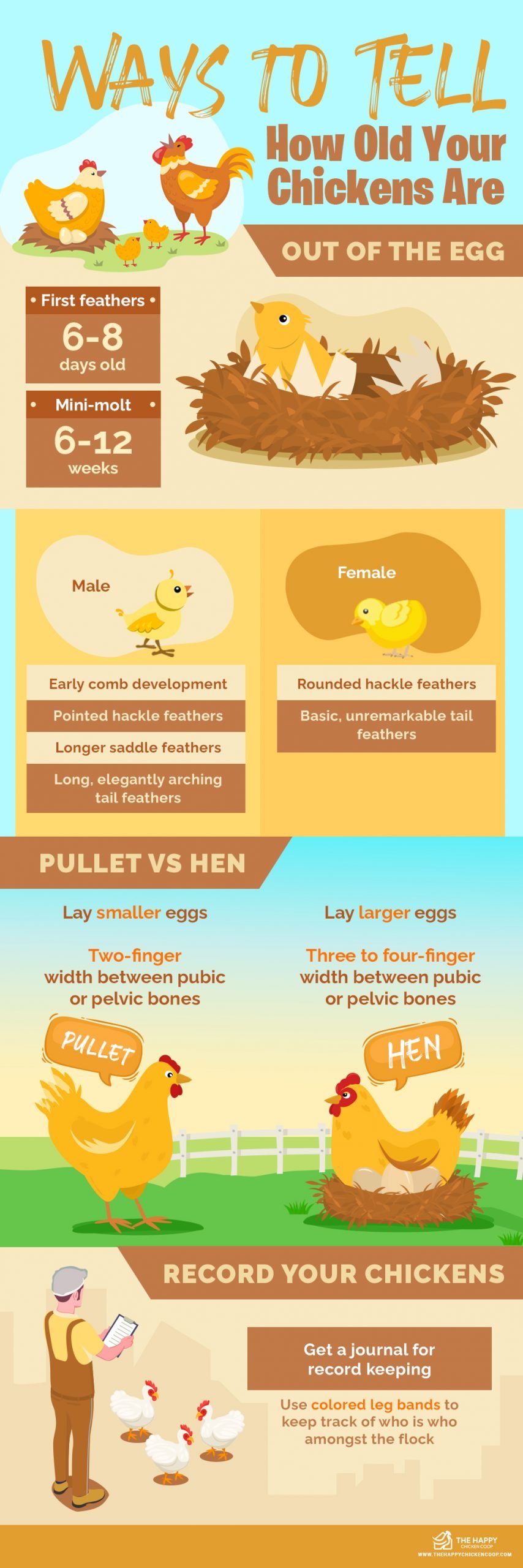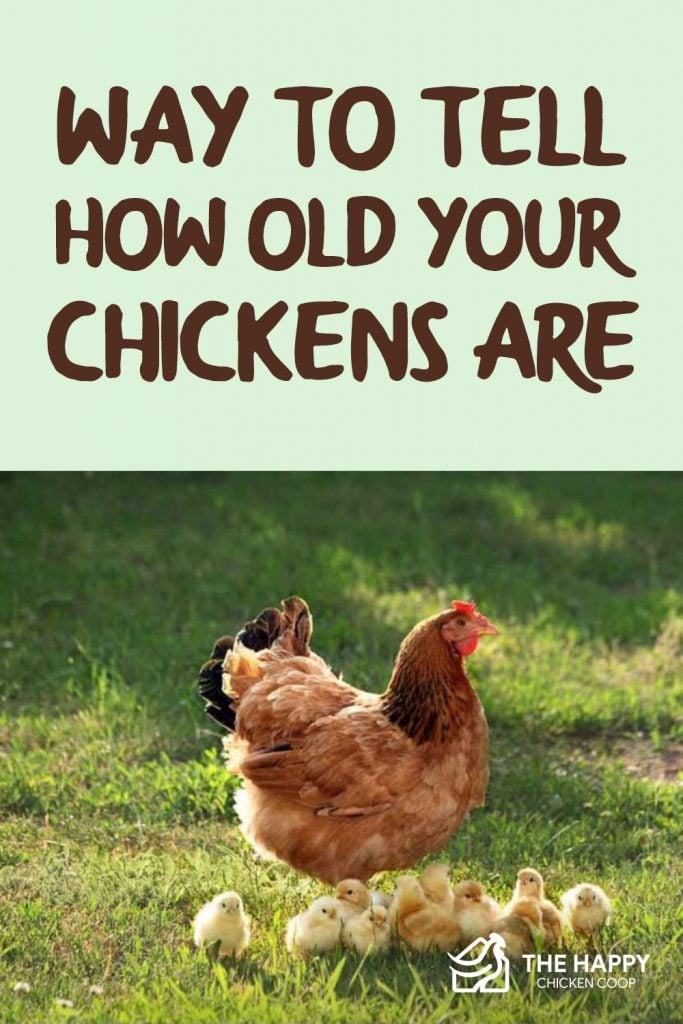How Old Are Baby Chicks When They Are Sold
Virtually people know the approximate age of their birds when they starting time get them.
But how do you know their age if yous are given some birds or rescue some?
Knowing the age of your chickens is crucial. Without it, it isn't piece of cake to know their egg-laying power, what to feed them and what their full general wellness should be.
Aging a craven is apparently non an verbal science, and some breeds are exceptions to the 'normal' rules, and so the all-time you can do is get an approximation.

Most backyard chickens live to an average age of six to eight years, but at that place are exceptions! A hen that is kept as a pet is probable to live longer than her outside foraging sis.
There are several clues to exist found on close inspection of your birds.
We will look at your chicken through its lifetime and give you lot the power to 'engagement' your chicken with a good amount of confidence.
These tips will help you brand a reasonable 'guesstimate' of the age of your chickens.
It volition besides assist y'all to tell the divergence between pullets and cockerels before they crow!
Out of the Egg
This is the first phase of life.
Initially, they don't expect at all bonny, more similar semi-drowned blobs! After several hours in the incubator (or under mama), they dry to a fuzzy, fluffy trivial chick.
This is the cute lilliputian fuzzball we all adore.

Effectually vi to eight days erstwhile, the chick will start to abound its first feathers. This gives it the appearance of a terrible haircut, the fuzz sticks out at angles, and the feathers are incomplete at this stage.
The chick will get-go to have a mini-molt anywhere from 6 to twelve weeks when its commencement total set of feathers will grow in. It's around this time that you tin can brainstorm to spot the deviation betwixt hens and cockerels.
By this fourth dimension, you will find which chicks seem more assertive, less fearful, and seems to stand more upright- keep an eye on this chick. It may be a boy!
Also, observe the comb on your chicks- boys tend to start growing their combs more than the girls, and their anxiety and legs tend to exist sturdier.
The feather difference is the giveaway, though! Equally the feathers of the mini-molt commencement to come in, you can see the departure between them:
- Cockerels tend to accept pointed hackle feathers effectually the neck; hens' feathers will exist more rounded.
- Saddle feathers on a rooster grow longer and more pointed than a pullet. If you're not certain where to look for saddle feathers, call back of where you would place a saddle on the bird.
- Sickle feathers- these are the long, elegantly arching tail feathers that roosters have. Hens have basic, unremarkable tail feathers.

So now yous know the difference in feathering, an unscrupulous seller won't be able to offload roosters onto y'all!
Please keep in mind that some breeds develop quicker than others, so that the timeline will change slightly with the breed.
For example, I can tell the sexual practice of my Barbu D'Uccles by vi weeks or so, only I cannot all the same encounter the difference in my Bredas'.
How Sometime is My Pullet?
A pullet is a hen that has not withal come into lay. The average historic period when a pullet starts to lay is near xx weeks.
Some sex link birds outset to lay at xvi weeks, while Orpingtons' can go to twenty-8 weeks! Pullets continue to put on body mass between twelve and twenty weeks.
If the pullet is about the size of an developed hen, she is about the 20-week marker.
Immature Pullets
Young pullets (and roosters) await and deed like bad-mannered teenagers. They aren't cute at this stage and are usually a flake pushy. Still, they are soon reminded of their lower 'status' by the older ladies!
They will presently blossom into fine-looking hens and roosters and volition find their place in the flock.
As they age, their combs become fuller, more adult, 'fleshy,' and a more vibrant red, equally do the wattles.
At that place are some breeds out there that don't have noticeable combs and pocket-size wattles, the Breda fowl, for example, it'southward a flake trickier to 'age' them, but yous tin do it with careful observation and practice.
If you are ownership pullets, make sure they are in practiced wellness. They should look robust, be agile, eyes should be bright and alarm, and the feathers should have a glossy sheen to them.

If the bird looks nothing like this- don't buy it.
Once the pullet starts to lay, she becomes a hen.
A young hen volition lay smaller eggs at the beginning of her laying 'career.' They also tin can be soft-shelled, misshapen, and infrequent.
In one case her egg-laying mechanism has kicked into full throttle, the eggs will get larger, and she will lay four to five eggs a week on average.
Another way to tell the departure between a pullet and hen is past checking the width between the pubic (or pelvic) bones.
You should be able to feel these basic on either side of the vent. With a pullet, the finger width between these ii bones will be around two-finger latitude.
In a laying hen, the basic are more distant, and you lot should be able to fit three or four finger breadths betwixt them.
How Old is My Hen?
If you are new to chickens, this may seem similar an impossible question to reply. After all, they don't come with birth certificates!
Personally, I keep a tape of my chicken's ages in with their health records and then that I tin come across at a glance how former, where did I buy, etc.
However, it is possible to eyeball a bird and give an approximate historic period visually.
If the bird has not yet had her first full molt, she can be anywhere from twelve to effectually eighteen months.
The showtime full molt is effectually fifteen to eighteen months- she will non molt until she has passed the twelve-calendar month marker.
If your coop looks similar an explosion in a pillow factory- they are molting. The speed with which they end the molt and grow new feathers is variable. Information technology is said that expert layers will molt and re-feather speedily. The molt can final anywhere from two to 4 months.
Young Birds
Young birds tend to look vibrant and total of life. The feathers have a proficient, glossy sheen to them, the comb and wattles are fully red, eyes bright and curious, shank, and feet have a good solid color.
They always seem to have lots of energy and spirit- they want to explore anything and everything to the point where they seem oblivious to danger sometimes!
Older Hens
An older hen is a bit more sedate and more similar a grandmother than a teenager! She volition come running for food and happily remind the younger girls' who is boss- a quick peck to the head will deter most of the younger hens.
She will have perfected the 'stink-center' look- this is the look she'll give you to note displeasure. It's every bit skilful as proverb, 'just what do you call up you're doing?'!
Her feathers will have lost a little of the gloss of younger birds, merely she should still look to be in good condition.
The feathers lose some of their 'tightness' over the years. This means they are not equally closely linked together as they are in younger birds. This gives a slightly disheveled look to some hens.
Combs
Combs will still be red but have a slightly different texture. The comb will likely accept a few pocket-sized scars from beingness pecked by her sisters. The lower-condition hens may even have some 'fingers' missing from the comb.
A roosters' comb tin be most 'dubbed' if he has been fighting for dominance. Dubbing is the removal of comb and wattles, occasionally earlobes. This practise is slowly dying out, thankfully.
The feet and legs of older birds tend to thicken, and the scales can exist slightly raised. The leg coloring will also look faded, and y'all may detect spurs.
If your hen has spurred, she is not a youngster!
By and large, they grow spurs around 3 years of age, and they grow in length over time – so long spurs equal an older bird.
Older birds can also suffer from a blazon of viral arthritis that causes tendonitis, causing them to move stiffly, much every bit a man with bad arthritis.
You will discover they walk a bit more carefully, go a bit slower, and generally avoid exerting themselves unless good cause arises.
To assist the older hens roost at night, endeavor placing some lower perches in the coop. Y'all can likewise rub a salve made of plantain into the legs.
Plantain is an herb that is considered antiseptic, reduces inflammation, and is also a pain reliever.
I use it not only with my chickens, but it likewise makes a hand cream for myself!
Record Your Flock
Equally you fall deeply in love with raising chickens, yous'll notice that your yearly additions, and new hatches, start to blend.
Later a while, information technology's hard to remember who is two years old and who is approaching retirement.
If yous're planning on keeping chickens for a long time, it's worth investing in a journal where y'all can do some tape keeping.
We employ colored leg bands to keep runway of who is who amongst the flock. Then, we mark down the flock and each chicken with their hatch day.
After a while, information technology becomes axiomatic that record-keeping is extremely useful for health records, fertility, and convenance.
Hands-down, the best way to tell how old your chickens are is to showtime keeping track of them on hatch mean solar day and every bit they develop and grow.
Bonus: tape-keeping also allows you to name each of your chickens, because…well, who doesn't proper noun their chickens and desire to go along track of each of them!?
Summary
You tin more often than not become a pretty good 'experience' for the birds' general historic period when you wait at a chicken. As you lot uncover the clues discussed above, they will help ostend (or not) your thoughts on the general historic period of the bird.
In that location are always exceptions to every dominion, just y'all will get a fairly good idea of your chicken's historic period if you follow the tips to a higher place.
Keeping records of development, characteristics, ages, and so on will help you think for time to come utilise and serve as a health tape.
Do you take whatever tips for identifying the age of your chickens- let us know in the comments beneath!
READ Adjacent: Chicken Heat Stroke and vii Shade Ideas for Your Flock

daughertyharioned49.blogspot.com
Source: https://www.thehappychickencoop.com/how-to-tell-how-old-your-chickens-are/
0 Response to "How Old Are Baby Chicks When They Are Sold"
Postar um comentário